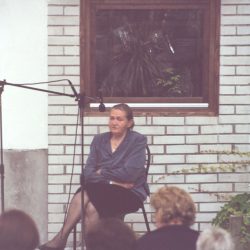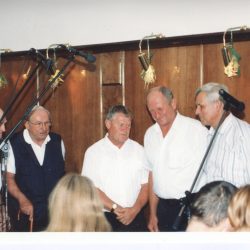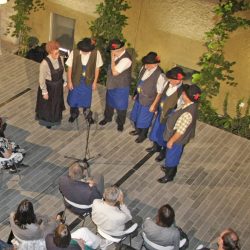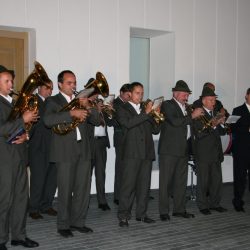Shout and Sing

Recorded: Ljubljana, 10. 9. 2004
Sung by: Fantje s Preske
Carol singing is a custom featuring carol singers going from house to house, wishing happiness and receiving a gift in return. When doing their rounds, carol singers normally sing carols that fit the context. Fantje s Preske preserve this tradition to celebrate St George’s Day by singing a St George‘s carol. Their multi-part male singing is peculiar for its so-called transpositional singing, meaning that they sing certain stanzas in another, usually lower, register.
Recorded: Ljubljana, 13. 9. 2003
Performed by: Tambura players from Sodevci
In the late 19th century, tambouras spread to Slovenia from other Slavic lands. Tamboura orchestras or the so-called tamboura ensembles formed an important part of cultural activity in many larger and smaller towns. Later, such groups began to focus their musical creativity into various genres of music, which is why the ensembles that still focus their activity on folklore are extremely rare. Sodevski tamburaši have been fostering their tradition of playing the prim, bas-prim, bugarija and berda since 1923, albeit with certain interruptions. They perform independently and also accompany the local folklore dance group.
Recorded: Ljubljana, 21. 9. 2012
Sung by: Sestre Jakob
It has been increasingly rare to encounter singing in family environment, which is the fundamental environment of transmitting spiritual culture. Common family activities are more intense in the time of living together, whereas later on they are normally limited to family celebrations. Five sisters of the Jakob family, who no longer live together, spend their time together on a regular basis, devoting it to singing folk songs. They find encouragement for socialising and singing in their stage performances where they present themselves to the public. Speaking of departure from the family and once known as a military song in the Koroška region, the love song The Sun was Shining so Low is sung in four-part manner.
Recorded: Ljubljana, 7. 9. 2007
Performed by: Musicians of Franc Ilec Loka Rošnja folklore ensemble
Nowadays, playing on a tree leaf is a mostly forgotten skill. It requires a certain amount of practice, skill and toughened lips to be able to tempt a sufficient amount of tones from the leaf. Such performance assumes the role of a melodic instrument, e.g. a clarinet, which is nowadays often included in ensembles. Similar sound can also be lured in the same manner from plastic materials, such as a piece of X-ray image. In the recording, two musicians from Loka Rošnja play on ivy leaves and a piece of plastic, while being accompanied by a musician playing the diatonic accordion.
Recorded: Ljubljana, 16. 9. 2011
Performed by: Janez Pezdirec
In the general public, the tradition of musicians from the White Carniola region is mostly presented in the form of tamboura ensembles. It is therefore often forgotten that the sound of the accordion is also a part of the local musical tradition, as well as the fact that the White Carniola tradition is part of the so-called central Slovenian soundscape. The musician performs the tune on the accordion that boasts specific sound and dictates a particular playing technique, and was made more than a century ago by Anton Mrvar, a Slovenian emigrant to the USA.
Recorded: Ljubljana, 10. 9. 2004
Sung by: Female folk singers from Zgornji Leskovec
Twelve Maidens Go to Work is a former song of farewell or a memorial song and is now seen as a narrative song. Farewell songs used to be composed at tragic events, such as when a girl drowned, but later the details were lost. The singers perform the song in four-part manner, which used to be common almost everywhere across Slovenia, but nowadays its occurrences are rare. The music structure of the traditional multuipart singing is different from how multipart singing is formed in choirs, as there are two more voices to be heard above the leading melody. There is also the third voice above the bass melody, the so-called na tretko, which typically remains limited to one or two tones.
Recorded: Smlednik, 28. 3. 2006
Performed by: Bell-ringers from Smlednik
Across Slovenia, bell chiming is a very common musical practice. Its main purpose is to celebrate church holidays. However, bell chimers also get together at various events, such as bell chiming contests and gatherings, while also being active in bell chiming courses and cooperating with other musicians. Bell chiming tunes are of diverse musical structures: the recorded track is a so-called flying tune, meaning that one bell is swung, while the bell chimers are sounding the others by hitting the clapper against the bell walls to create a rhythmic pattern. The bell chimers from Smlednik have been fostering the tradition of bell chiming for decades.
Recorded: Ljubljana, 10. 9. 2004
Sung by: Nediški puobi
Nediški puobi originate in Veneto, where Slovenian and Italian spiritual cultures are typically intertwined. The connectedness of the two cultures is also clear from the ensemble’s jocular song I Saw Marjanca, which is part of Slovenian Veneto and Friuli musical tradition. In Veneto, the waltz is often danced to instrumental versions of folk melodies; likewise, they used to accompany I Saw Marjanca by dancing potresavka: a special type of waltz marked by shaking one’s body (Ramovš, 1999: 201–202). The way the singers from the Nadiža Valley conduct their voices – particularly baritone – and sing, expresses the historical traces of a choir tradition in their region.
Recorded: Ljubljana, 29. 6. 2000
Sung by: Marija Varga
Just like the Slovenian minority in Hungary, the Hungarian minority in Slovenia also fosters its own folk tradition, which also combines with the tradition of the majority population of the country they live in. This is also reflected in music: the tetratonic and C-pentatonic melodies of Slovenian two-part songs combine with the Hungarian A-pentatonic monophony tradition. Originating in the tradition of the Hungarian minority and being sung by Marija Varga from Dobrovnik, this narrative song tells of an orphan boy at the cemetery on a winter evening, lamenting over his dead mother, no longer being able to muster the strength to return home. In the morning, he is found dead.
Recorded: Ljubljana, 7. 9. 2001
Played by: Mlada beltinska banda
Peripheral or border regions of a certain nation differ from other regions, which is no less true for musical features, as they often integrate the influences of the neighbouring cultures. In the Prekmurje region, it is therefore still common to encounter an ensemble otherwise typical of the wider Pannonian area. Music ensembles of Prekmurje, called bande or bands, mostly depended on what musicians were available at a certain place. Continuing the rich music tradition of bands of Beltinci, such as the Banda Kociper-Baranja or Marko banda, Mlada beltinška banda therefore features the violin, cimbalom, clarinet, accordion and double bass.
Recorded: Ljubljana, 28. 6. 2002
Sung by: Village carolers from Velika Dolina
Nowadays, carol singers most often do their rounds in winter, particularly to celebrate the Three Wise Men, whereas Christmas and New Year’s carols have mostly receded due to a changed way of celebrating the holidays. Melodically, carol songs are no different from other Slovenian folk songs. In content, however, a carol contains some typical elements, such as greeting to the house, description of the event, request for a gift, blessing or greeting, gratitude for the gift and farewell. Carol singers from Velika Dolina have revived the forgotten Christmas/New Year’s carol Dark Night has Fallen, to which they added a spoken greeting at the end.
Recorded: Ljubljana, 7. 9. 2007
Performed by: Veronika Zajec
The violin zither is a real rarity in Slovenia. The backing melody on the instrument is played with a pick and the lead melody by drawing a violin bow against the strings. Veronika Zajec was taught to play the instrument by her grandfather, the late Jože Zajec. He was a self-taught musician who played the violin zither both at dances and in family settings. Likewise, when playing the violin zither, his granddaughter Veronika performs dance tunes and folk melodies, such as the tune I Shall not Pluck Flowers.
Recorded: Ljubljana, 9. 9. 2005
Sung by: Romana and Ana Črnko from Gradišče na Kozjaku
The two-part singing, consisting of one singing the lead and the other one above, is presented by this mother-daughter duo from Gradišče na Kozjaku who practice singing several narrative songs from memory. Among them, I Shall Go to the Monastery to Become a Nun, tells of a girl committing suicide after having had to go to a monastery after experiencing love. The medieval setting of what used to be a very common song in central Slovenia supposedly reaches back to the 16th century, whereas its first known written sources date back to the late 19th century. In various versions the song remains part of the folk song repertoire.
Recorded: Ljubljana, 25. 9. 2009
Sung by: Kapelski pubje
An increasing number of people intentionally maintain Slovenia’s folk song tradition. This singing group from Kapele is mostly composed of young men reviving the local singing tradition. Their main principle is a love of singing, which also shows in their repertoire consisting of Slovenian folk songs as well as choir and Dalmatian songs. The song Good Morning, My Milka is a male three-part song, with the upper voice, which the singers refer to as cvik, sometimes reaching the upper octave.
Recorded: Ljubljana, 3. 7. 1998
Performed by: Folklore ensemble Val Resia
Resian instrumental music consists of playing the cítira or violin and bunkula or cello. The musician playing the cítira has their instrument tuned higher, plays the lead melody and stamps their foot on the ground to provide rhythm, whereas the musician playing the bunkula accompanies them by plucking the open strings emphatically. The tune has two parts, the one tuned higher being referred to as na tenko or thinly, and the one tuned lower na tolsto or thickly. In the recording, the musicians were accompanied by the members of a folklore dance group singing and dancing.
Recorded: Ljubljana, 10. 10. 2008
Sung by: Trstenke
The typical combination of traditions of various lands in border regions is also reflected in the song My Darling, which has been adopted from the Croatian folk repertoire. A variant of the song with the first line Moj se dragi po Meriki šeće or My Darling wanders through America, is also known in the music tradition of Kostel. In the Haloze region, when carrying out the first field recordings, the researchers of the Institute of Ethnomusicology marked a strong centre of four-part singing, and noticed that folk singing in Haloze was shriller, louder and more open. Such singing is also typical of the female folk singers Trstenke from Podlehnik.
Recorded: Ljubljana, 10. 7. 1998
Sung and performed by: Istrijanski mužikanti in Kantadori
The Istrian music tradition is a combination of Croatian, Italian and Slovenian poetry and musical features. Local Istrian musicians and folk singers, as such, normally do not define their tradition as Slovenian, but rather Istrian. A common Istrian ensemble of musicians was composed of the violin or škənt, škəntič, žiongič, a diatonic accordion of Trieste origin or trieština, a clarinet and a two string cello or bajs. In the recording, the musicians accompany jocular songs, the likes of which circulated around Istria after World War II.
Recorded: Ljubljana, 9. 7. 1999
Sung by: Folk singers from Obirsko
Four-, five-, or even six-part singing with an older technique of leading voices was most commonly recorded in the Koroška region and was thus at first considered a local particularity. However, researchers later discovered that such singing was spread in other parts of Slovenia as well. Yet the softness and full sound, which were transferred from the choir aesthetics to folk music expression and can be heard when listening to Carinthian Slovenians from Austria, are typical of singing folk songs in the Koroška region.
Recorded: Ljubljana, 25. 9. 2009
Sung by: Folk singers from Cirkulane
With folk singing disappearing from everyday and festive life and being transferred into stage forms, some singers have formed regular singing ensembles. The same goes for singers from Cirkulane, who take their singing skills and knowledge of songs from their local music tradition. They present the local way of singing in the group of four male singers and a female singer singing the highest voice referred to as prek, črez or over.
Recorded: Ljubljana, 13. 9. 2003.
Performed by: Trio dva čardaša
The tamboura ensemble Trio dva čardaša from the White Carniola region, (actually composed of more than three members), can be labelled a revival music group. Its members are educated musicians who play in folklore dance groups, while also exploring the expressive possibilities of tamboura orchestras. They play Roma songs, Croatian starograd tunes, folk music from various parts of the world as well as adaptations of popular and classical music. Čardaš is among the most popular dance tunes from their repertoire.
Recorded: Ljubljana, 16. 9. 2011.
Sung by: Female folk singers from Adlešiči
To collectors of songs, the female folk singers from Adlešiči are mostly known as Midsummer Maidens or the singers who still maintain the tradition of carol singing on the Midsummer Day. In front of houses where they wish happiness they sing a Midsummer carol, but while walking over fields from house to house, and from village to village, they also sing other songs like A Bird has Come. This song originates in the ballad The Death of the Shoemaker’s Mistress from the Kočevje region and elsewhere in Slovenia, but its original narrative structure has been changed considerably (Terseglav, 2011: 26).
Recorded: Ljubljana, 7. 9. 2007.
Performed by: Frajhajm brass band from Šmartno na Pohorju
The brass band from Šmartno na Pohorju has been active since 1827. It originates in the times when the nearby glassworks employed many Czech workers, therefore the founder and first leader of the orchestra was Simon Jurič of Czech origin. In its repertoire, the orchestra mostly preserves old tunes, like Slovenian, Austrian and Czech polkas, marches and waltzes, among them the Czech tune A Polka for Lojzka.
Recorded: Ljubljana, 16. 9. 2011.
Sung by: Dragatuš folklore ensemble
Nowadays, ensembles of singers and musicians active as part of folklore groups are considered important transmitters and preservers of folk music traditions. Often performing independently, such ensembles also attract young musicians. The love song White Dove, which is sung in a three-part manner by a mixed group of singers from Dragatuš, is part of the Uskok tradition. It used to be common among the Slovenians in the White Carniola region, where it still remains present among the Orthodox inhabitants of Bojanci.
Recorded: Ljubljana, 21. 9. 2012.
Sung by: Marija and France Anzeljc
As there are fewer and fewer spontaneous opportunities to sing folk songs with other singers, the married couple Anzeljc, with the domestic name of Petrač, most often sing alone. For the past twenty years they have often performed on stage, where despite their singing expression they maintain the hint of homeliness and ease. The song When the Moon Begins to Shine, which is their favourite, is of newer origin and can therefore be found in folk tradition as well as in repertoires of folk-pop music bands.
Recorded: Ljubljana, 10. 10. 2008.
Sung and played by: The Robnik sisters and musician Ivan Retko
The Robnik sisters, Jožica Pustoslemšek and Marija Kramer foster the tradition of family singing. Their joyful character is expressed in their toasts which they continue to sing at weddings. Toasts are lively songs that used to be of ceremonial character and were once sung at weddings as part of the štajeriš dance, but today they are mostly occasional jocular songs, which is also expressed by the final stanza of the recording. The toast aimed at the people attending the Shout and Sing event was sung by the musician accompanying the singers on the diatonic accordion.
Urša Šivic: Shouting and Singing at Novi trg, Ljubljana
Looking at the refurbished atrium of the Slovenian Academy of Sciences and Arts (SAZU) just below the premises of the Institute of Ethnomusicology of SAZU Scientific Research Centre, the colleagues Maša Komavec Marty, MA, and Robert Vrčon, MA, got the idea to fill the space with the folk music that they knew well from their field recordings and scientific explorations. With the assistance of Radovan Arnold (arnoldvuga+), the event Shout and Sing was born in 1998 as a music event that first held the unambitious title Gathering of folk singers and musicians from Istria. The very first event attracted numerous listeners, therefore the repeated edition in the following year – already with the striking title Shout and Sing – was expected to happen.
The way it is understood today in more or less old-fashioned frameworks, folk music lives in rural environments as part of diverse organised or spontaneous occasions. Such music had been brought to Ljubljana within some other events, but only in fragments. Shout and Sing was therefore the first event to have assumed the task of presenting ‘non-urban’ folk music within an urban setting. This is a purpose that was not very pronounced in 1998, but later on became one of the main aims for holding music events.
In contrast to events featuring more recent types of folk music creativity, the organisers of Shout and Sing have been striving to present the singers and musicians who still draw from their family and local music tradition. We are thus looking for an older tradition, which is not a limiting concept. Modern ways and forms, as well as younger performers of this segment of music culture are also presented in specific examples. As we transform our field experience and ‘office’ knowledge into a considerate concept and provide expert comments to the event programme, the content of Shout and Sing events gives our scientific work a new dimension.
In the years 1998–2012, the programme of Shout and Sing was devised by Maša Komavec Marty, Robert Vrčon, Mirko Ramovš, Marija Klobčar, Marko Terseglav, Mojca Kovačič and Urša Šivic. In these years the series travelled the map of Slovenian creativity in music, integrating diverse ideas in particular events: regionally, the presentations covered Resia, Istria, Slovenian Veneto, Slovenian Raba region, Austrian Carinthia, White Carniola; ethnically, the Hungarian and Italian minorities; by type of poetry, narrative and military poems as well as carols; by music features, male singing, folk music creativity of women, family singing, and various types of Slovenian folk singing; and by type of instruments, the violin, the tamboura, small instruments and bell chiming.
Folk music nights at Novi trg are visited by connoisseurs as well as lovers of folk music. To the latter, this event that takes place in Ljubljana provides a rare opportunity for those who do not otherwise experience folk music in their everyday lives to broaden their knowledge of and interest in folk music. Shout and Sing thus adds a new encounter to their existing experience in music and culture. However, visitors also include experts, connoisseurs of folk music in organised and spontaneous settings, to whom Shout and Sing is one of many diverse forms of folk music occurrences.
After fifteen years and seventeen events, Shout and Sing has become a well-known event and a ‘brand’ of the Institute of Ethnomusicology. It is a multimedia event, enhancing folk music with expert commentary and inventive designs as well as authentic cuisine, spontaneous singing and socialising.
If in 1998 the purpose of the event was to bring folk music from the archives to be performed live, it has also been an event that, repeated over fifteen years, brought much audio material to the archives of the Institute of Ethnomusicology. This audio publication brings the material back to listeners to serve as a proof of the colourful and diverse Slovenian folk music tradition and the versatility of its performers.
Maša Komavec Marty:
One fine day in the late 1990s, an idea was born that the ethnomusicologists working at the ZRC SAZU Institute of Ethnomusicology should bring the singers and musicians whom they encounter during their fieldwork to a stage in Ljubljana. Thus they would hold a ‘doors open day’ for everybody wishing to know what can be found in the archives, and wishing to hear how people sing and play in nearby places, in villages near and far, in other towns or even other countries. Thus the singing and playing would make the listeners aware of the features or particularities of a certain performer, place or music repertoire. This would be a concert for everybody interested in the other side of such music. The Shout and Sing event had been conceived to present the music that ethnomusicologists encounter among regular people. An event was born that was not limited to a certain place or music genre. From then until today, it is an event that expresses gratitude to all the informers, singers, musicians and bands who generously invite researchers into their homes and into their musical worlds.
Mojca Kovačič:
The aim of this audio publication is to cover the diverse contents of all Shout and Sing events that took place over fifteen years, both in their regional and music content, and thus to present the essential features of Slovenian folk music. As the events featured almost sixty groups and individuals performing folk music, a selection of the recordings had to be made. Often, the selection depended on the quality of the recording on stage, which is not normally the primary performing setting for musicians and singers. This new setting could caue stage fright and insecure performance. However, the technical weak points were partly subdued to interesting ethnomusicological features of the material that was presented. To sum up, the audio recordings are actually live recordings of events and therefore field recordings of Shout and Sing with all the accompanying technical imperfections and advantages. The publication provides the recorded material with expert commentary, emphasising the role of performers in each recording, or drawing from the theme of the event where the recording was made.











